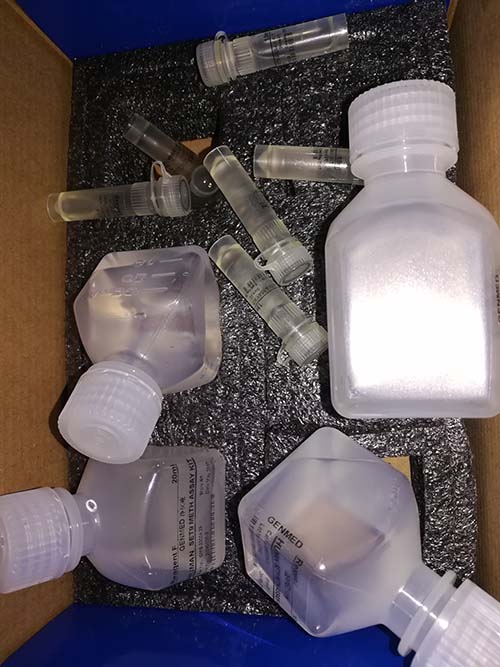EPSPS gene nucleic acid detection kit instruction manual
EPSPS gene nucleic acid detection kit (PCR-fluorescent probe method SN standard) ◆ Product Description The transgenic detection series can amplify specific nucleic acid fragments of transgenic components in food, feed and other samples, and judge the results by real-time amplification curve. This product is used for the detection of EPSPS gene components with a detection limit of 0.1% . ◆ Product composition (48 test) 041112M Reagent content A-EPSPS-P 1000μL × 1 NG- P 100μL × 1 PG-EPSPS-P 100μL × 1 A PCR instrument such as a fluorescent PCR machine (ABI 7500, CFX 96, Mx 3005P, LineGene 9600). ◆ Self-supplied supplies and instruments 1 sterilize 1.5mL or 2.0mL centrifuge tube; 2 sterilize 0.2mL PCR tube or octa tube; 3 ice box; 4 pipette (11-10μL, 10-100μL, 100-1000μL) and matching sterilization tips 5 centrifuge; 6 vortex mixer; 7 metal bath; 8 homogenizer, mixer or mortar and other grinding equipment; 9 electronic balance. ◆ Notes 1. This reagent has high detection sensitivity. In order to prevent pollution, the experiment is to be partitioned. 1) First zone: reagent preparation zone. 2) Second zone: sample preparation area. 3) Zone 3: Amplification and product analysis zone. ★ It is best to physically isolate the partitions to avoid contamination caused by human factors. 2. Wear work clothes and latex gloves during the experiment, use pipettes, and treat all waste generated in the test in time. 3. Strictly follow the operation steps, reagent preparation and sample loading steps should be carried out on ice in strict accordance with the instructions. 4. The components in the reaction solution are sensitive to light and should be stored away from light. The reagent should be completely thawed before use, but repeated freezing and thawing should be avoided. It is recommended to centrifuge for 30 seconds before use, and store the reaction solution in an appropriate volume according to the frequency of detection. 5. After the reaction is completed, the expansion tube should be placed in a sealed bag and discarded. On the same day, the lid is opened and the aerosol is easily contaminated. It is forbidden to open the lid. 6. Do not mix and use different batches of reagents and use them within the validity period. ◆ Sample processing Samples prepared by the method of GB/T 19495.3-2004 Detection of nucleic acid extraction and purification of genetically modified products or other standards are prepared and used for storage. For detailed steps, please follow the standard operation or check the food safety software. ◆ Experimental operation The reagents were completely thawed and the components were centrifuged for 30 s. 1. Reagent preparation (reagent preparation area, placed in an ice box): If there are N samples to be tested, refer to the table below, calculate the amount of reaction solution according to N+2 (N samples to be tested + 1 negative control + 1 positive control), vortex and mix, centrifuge for 30s, divide Installed in a 0.2 mL PCR tube. Reagent Usage amount A-EPSPS-P 20×(N+2)μL Total volume of reaction solution 20×(N+2)μL It is recommended to use the supporting plant genomic DNA extraction series products. The specific process is detailed in the product manual. 3. Add a template (sample preparation area, placed in an ice box) In the PCR tube containing the reaction solution in step 1, 5 μL of template was added, respectively, in the order of NG-P, sample template to be tested, and PG-EPSPS-P. The mixture was vortexed for 30 s, centrifuged for 1 min, and the PCR amplification reaction was immediately performed. 4. Amplification reaction (amplification and product analysis area) Using a real-time PCR instrument, the fluorophore was selected for FAM and the quencher group was selected for TAMRA. Set up the amplification reaction according to the following conditions: PCR cycle Fluorescence collection site 95 ° C 10 minutes 1 cycle - 95 ° C 15 seconds 40 cycles - 60 ° C 1 minute ※ 6. Baseline and threshold settings The baseline adjustment takes 3-15 cycles of fluorescence signal, and the threshold line should exceed the highest point of the negative control amplification curve. ◆ Result judgment The sample has no Ct value, and the curve is straight or slightly oblique. There is no “S†type amplification curve, and the sample can be reported negative, and the EPSPS gene is not included or the content is lower than the detection limit; The test sample Ct ≤ 36, the curve is an "S" type amplification curve, which can directly report the sample positive, containing the EPSPS gene; Test sample 36 A Foot Spa Machine with heat is a device used to provide a relaxing and therapeutic foot massage. It usually has a basin filled with warm water and has various massage settings such as vibration, bubbles, and rollers. The heat function helps soothe tired and aching feet, while the massage setting provides a deep-tissue massage that helps improve circulation, reduce tension, and relieve pain. Some foot spas also come with removable attachments, such as pumice stones and brushes, for extra exfoliation and cleansing. Overall, a foot spa machine with heat is a great tool for anyone looking to pamper their feet and promote overall relaxation and wellness. Foot Spa Machine With Heat,Bubble Foot Bath Massager,Foot Massage Machine,Pedicure Foot Spa Machine Huaian Mimir Electric Appliance Co., LTD , https://www.mmfootbath.com